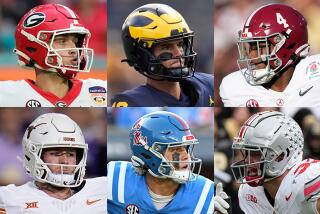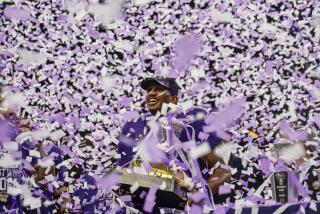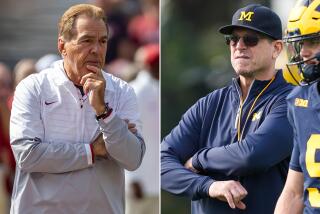COLLEGE FOOTBALL NOTEBOOK : Something Moore for the Heisman Race
- Share via
TACOMA, Wash. — Midway through the season, Ty Detmer apparently continues to lead the Heisman Trophy race, but Shawn Moore is gaining on him.
Detmer’s season-opening performance against Miami vaulted him to the early lead, but as Virginia’s acceptance as a candidate for the national championship has increased, so has the stock of Moore.
An informal poll of eight sportswriters from around the country this week suggests Moore is closing the gap, and with No. 1 Virginia’s showdown looming Nov. 3 with No. 11 Georgia Tech, he could leapfrog the Brigham Young University quarterback.
Like the national championship race, the Heisman race looks as though it will be interesting to the wire, with Miami quarterback Craig Erickson possessing an outside chance because the Hurricanes play Notre Dame on Saturday in what promises to be one of the most-watched games of the year.
-- For Detmer to hold off Moore, the BYU Cougars probably will have to win the rest of their games (including the Nov. 10 biggie at Wyoming). If they win and he wins, BYU would advance to the Holiday Bowl, giving that bowl game the Heisman winner for the second time in three years (Oklahoma State’s Barry Sanders in 1988).
-- For Moore to overtake Detmer, Virginia probably will have to win the rest of its games. That would give the Cavaliers an opportunity to be the first combination of national champion-Heisman Trophy since Tony Dorsett at Pittsburgh in 1976.
With Virginia ranked No. 1, the Florida Citrus Bowl could wind up as the big winner in the bowl derby. The complicated contract between the Atlantic Coast Conference and the bowl game in Orlando, Fla., gives the ACC champion an escape clause to accept an invitation to the Orange, Sugar or Cotton if the money is better and the team could win the national championship.
But the contract has another clause that allows the Citrus Bowl to keep such an attractive ACC team by matching the guarantee the other bowls offer. That means if either Virginia or Georgia Tech is ranked first, second, third or fourth on Nov. 13 (invitations officially go out the 24th), the Citrus Bowl has the option of kicking up its $1.2-million guarantee to the $3-million-plus the others offer.
That’s an easy call if Virginia is still ranked No. 1 ... ABC would kick in whatever is necessary and attempt to move the morning game to prime time, attracting Notre Dame, Miami, USC, Auburn or Tennessee.
For one reason or another (injuries, subpar play), six teams in the Pacific 10 Conference have changed starting quarterbacks since the season began, and experience is at a premium.
At the extreme end, Washington State is going with true freshman Drew Bledsoe (in place of struggling senior Brad Gossen). Three teams have redshirt freshmen doing the job (UCLA’s Tommy Maddox, Oregon State’s Fred Schweer, Arizona State’s Bret Powers), and three are relying on sophomores (USC’s Todd Marinovich, UW’s Mark Brunell, Arizona’s George Malauulu).
Oregon has little-used junior Bob Brothers taking over for injured senior Bill Musgrave.
That makes Brunell and Cal junior Mike Pawlawski tied for third (six starts) as the most experienced starters in the league this week behind Marinovich (18) and Stanford junior Jason Palumbis (13).
Most teams gear up for conference games, with championships and bowl bids on the line. In the Big West, the champion gets a trip to the California Raisin Bowl.
That apparently doesn’t send a charge through Sheldon Canley and his San Jose State teammates, who played well through a tough non-conference slate, barely losing to Washington and California, while beating Stanford and tying Louisville.
“We kinda played at Long Beach’s level for the first half of the game,” Canley said after beating the 49ers, 46-29. “Playing Pac-10 teams, you have to play at a certain level, and getting back to the conference, you tend to find yourself not taking it that seriously.”
When Stanford Coach Dennis Green stands on the sidelines facing the Washington Huskies on Saturday, he feels like it will be the first time for him.
It isn’t. In 1984, as coach of Northwestern, Green watched his Mildcats get ripped by the “Purple Reign” Huskies, 26-0.
When he was asked if this UW team is as good as that 1984 11-1 model, Green didn’t hesitate, saying: “I don’t remember that far back -- I never talk about the (10-45) Northwestern days.”
The biggest game in the country this week is, of course, Miami at Notre Dame. It has been a great series between two great programs in recent years, although games usually have been nothing special. Of the 16 games the teams have played since 1973, 14 have been decided by 10 or more points and 10 have been 20-point routs.
The great game of the day Saturday might be Florida State at Auburn. The Tigers have won or shared the past three Southeastern Conference championships, but each season have lost to Florida State. Auburn has won 20 consecutive home games since losing to the Seminoles, 34-6, on Nov. 17, 1987. Overall, the Tigers are 26-2-2 since then, the Seminoles 28-4.
Oil up that clicker for the workout it’ll get at 12:30 p.m. PDT, when No. 13 Washington takes its Rose Bowl quest to Stanford on ABC, and No. 2 Miami is at No. 6 Notre Dame on CBS.
Others to watch: Iowa at Michigan, ESPN, 9:30 a.m. PDT; Alabama at Tennessee, ESPN, 1 p.m. (during commercials and injuries in the two 12:30 games); Florida State at Auburn, ESPN, 4:30; Arizona State at Oregon, Prime Sports, 7 p.m.
Atlantic Coast: No. 1 Virginia (6-0) has one more hurdle before a bye and then the big game against No. 11 Georgia Tech (5-0). That hurdle is just 2- 4 Wake Forest, although it should be noted that top-ranked teams are 3-3 this year, including losses in each of the past two weeks.
Big Eight: This is turning out to be an outstanding year for the Big Eight. Despite Oklahoma’s 14-13 loss to Texas, the league finished non-conference play with a 20-12-1 record (its best since 1983) -- which includes a 6-0 mark against the Pac-10.
Big Ten: Because Michigan State nipped Michigan, 28-27, this side of the Rose Bowl race is wide open, with No. 8 Illinois, No. 22 Iowa and perhaps No. 20 Indiana making a run at the Michigan schools. This week, Iowa is at No. 10 Michigan and No. 24 Michigan State is at Illinois.
Big West: Utah State running back Roger Grant is rushing for 118.2 yards per game, ranking ninth in the country. He’s averaging 244.5 against Big West opponents, 34.0 against non-conference foes (Utah, Missouri, Oregon) -- and his next four games are league contests.
Independents: Louisville (5-1-1) has blocked seven kicks, including three field goals that would have beaten them in the final 90 seconds. Saturday, the Cards face Pitt (3-2-1), which has blocked four kicks.
Pacific 10: Two teams that have been going in opposite directions since they last met, square off in Berkeley, Calif. When UCLA beat Cal on Sept. 30, 1989, it marked the Bruins’ 24th victory in 30 games, while the Bears were 10-17-3 during that time. Since then, the Bruins are 4-8-1, and the Bears are 7-6.
Southeastern: No. 3 Tennessee seeks some revenge from Alabama, which ruined the Vols’ perfect season in 1989, 47-30. It’s also homecoming in Knoxville, and the Vols are favored by 11 points -- believed to be the largest spread ‘Bama has ever seen the ‘dog side of.
Southwest: Speaking of revenge ... in ‘89, Houston humiliated SMU, 95-21. They square off again Saturday in Dallas. The No. 9 Cougars (5-0) have been less dominant, and the 1-4 Ponies have been more competitive, but it probably still will be a rout.
Western Athletic: Although New Mexico lost to Wyoming, 25-22, coach Mike Sheppard got two TDs from his new “twin fridge” goal-line backfield of Monte Cuba (6-foot-2, 282) and John Bell (6-2, 255), who are normally defensive linemen. Said Wyoming coach Paul Roach: “I’ve never seen two refrigerators in the backfield -- and they weren’t those portable types, either.”
More to Read
Go beyond the scoreboard
Get the latest on L.A.'s teams in the daily Sports Report newsletter.
You may occasionally receive promotional content from the Los Angeles Times.










